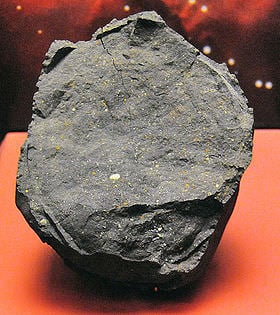[/caption]
New analysis of the famous Murchison meteorite that crash-landed in Australia over 40 years ago shows the space rock contains millions of previously unidentified organic compounds. Researchers say the meteorite, which is over 4.65 billion old – and likely older than our Sun -- offers evidence that the early solar system likely had a higher molecular diversity than Earth, and may offer clues to the origins of life on our planet.
[caption id="attachment_56249" align="aligncenter" width="200" caption="Pair of grains from the Murchison meteorite."]
[/caption] Philippe Schmitt-Kopplin from the Institute for Ecological Chemistry in Neuherberg, Germany and his colleagues examined the carbon-rich meteorite with high-resolution structural spectroscopy and found signals representing more than 14,000 different elementary compositions, including 70 amino acids in a sample of the meteorite.
Schmitt-Kopplin said that given the ways in which organic molecules with the same composition can be arranged in space, the meteorite should contain several million different organic chemicals.
The Murchison meteorite landed near a town of the same name in 1969. Witnesses saw a bright fireball which separated into three fragments before disappearing, leaving a cloud of smoke. About 30 seconds later, a tremor was heard. Many specimens were found over an area larger than 13 square km, with individual masses up to 7 kg; one, weighing 680 g, broke through a barn roof and fell in some hay. The total collected mass exceeds 100 kg.
Earlier analysis of the space rock revealed the presence of a complex mixture of large and small organic chemicals.
The meteor probably passed through primordial clouds in the early solar system, picking up organic chemicals. The authors of the paper suggest that tracing the sequence of organic molecules in the meteorite may allow them to create a timeline for the formation and alteration of the molecules within it.
The results of the meteorite study are published in the
Proceedings of the National Academy of Sciences.
 Universe Today
Universe Today
